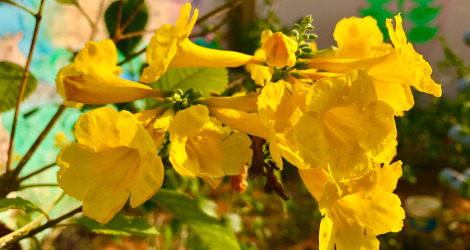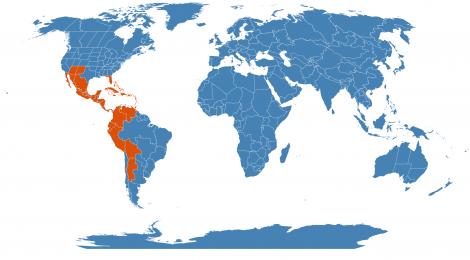Accession Data:
Tecoma stans (L.) Kunth ex HBK.
- Common Name: Yellow Bells
- Family: Bignoniaceae Juss.
- Description: "Shrub or small tree, much branched, twigs tan or reddish tan, smooth, scarcely 4-sided; leaves opposite, pinnately compound, leaflets 1-9, usually 3-7, ovate-lanceolate, apex acuminate, base acute or obliquely acute, very shortly petiolate or subsessile, slightly hirsute on midrib and in vein axils beneath, margins irregularly serrate, leaves quite variable, rachis and petiole slender, glabrous; inflorescence an axillary or terminal raceme, pedicels short, irregularly curved or twisted, bracts reduced to minute scales, flowers rather few, calyx narrowly cylindric-campanulate, 5-7 cm long, with 5 sub-equal acuminate teeth, glabrous; corolla bright yellow, narrowly campanulate, tube narrow, about 1 cm long, throat about 2.5 cm long, dorsiventrally compressed, with 2 longitudinal folds on ventral side, 5 sub-equal spreading orbicular lobes about 8 mm long, several faint diffuse reddish lines in throat; stamens 4, attached at summit of tube, in 2 unequal pairs, included, filaments pilose at base, curved above, anthers versatile, linear, yellow, pilose, 6 mm long; sterile fifth stamen much reduced; pistil about equaling stamens, ovary narrowly cylindric, about equaling calyx, style filiform, glabrous, stigma flat, elliptic; capsule linear, compressed, 10-20 cm long, 7-8 mm wide, brown when ripe, with raised line or suture lengthwise on each flat side, tardily dehiscent along suture, septum parallel with flat sides, firm, seeds flat, oblong, 7-8 x 4 mm, with a membranous transparent wing on each end, ends of wing erose, seeds entire including wing about 20 x 6 mm" (Fosberg et al, 1993).
Other Names: peeal (Puluwat), piti (French Polynesia)
- Uses: Medicinal Properties: Studies have shown effectiveness as
a diuretic, tonic, anti-syphilitic, and vermifuge.
Parts utilized: Entire plant.
Traditional Folk Uses: Roots are reported to be diuretic, tonic, anti-syphilitic and vermifuge. In Veracruz, decoction of flowers and bark are used for stomach pains. In some parts of Mexico and in central and south America, the plant is used in the treatment of diabetes.
Other Uses: In Guadalajara, roots used for making beer.
From Philippine Alternative Medicine
- IMPORTANT NOTE: Plant Uses are for informational purposes only. EEB Greenhouses assume no responsibility for adverse effects from the use of any plants referred to on this site. Always seek advice from a professional before using any plant medicinally.
- Culture: full sun, well drained soil with minimal water when not in active growth
- USDA Zone: 7-11
Accession Data:
- Accession # 198500662
- Source: Unknown
- Accession Date: 12-31-1985
- Bench: 1316 - NEOA: Ground Bed 2 SE
- Currently: active - healthy
- Qty: 3 confirmed on 03-24-2025
Classification:
- Division: Magnoliophyta
- Class: Magnoliopsida
- SubClass: euasterid I
- Order: Lamiales
- SubOrder:
- Family: Bignoniaceae
- SubFamily:
- Tribe: Tecomeae
- SubTribe:
Flowering Data:
This accession has been observed in bloom on:| Year | Jan | Feb | Mar | Apr | May | Jun | Jul | Aug | Sep | Oct | Nov | Dec | ||||||||||||||||||||||||||||||||||||||||
|---|---|---|---|---|---|---|---|---|---|---|---|---|---|---|---|---|---|---|---|---|---|---|---|---|---|---|---|---|---|---|---|---|---|---|---|---|---|---|---|---|---|---|---|---|---|---|---|---|---|---|---|---|
| 2025 | ||||||||||||||||||||||||||||||||||||||||||||||||||||
| 2024 | ||||||||||||||||||||||||||||||||||||||||||||||||||||
| 2023 | ||||||||||||||||||||||||||||||||||||||||||||||||||||
| 2022 | ||||||||||||||||||||||||||||||||||||||||||||||||||||
| 2021 | ||||||||||||||||||||||||||||||||||||||||||||||||||||
| 2020 | ||||||||||||||||||||||||||||||||||||||||||||||||||||
| 2019 | ||||||||||||||||||||||||||||||||||||||||||||||||||||
| 2018 | ||||||||||||||||||||||||||||||||||||||||||||||||||||
| 2017 | ||||||||||||||||||||||||||||||||||||||||||||||||||||
| 2016 | ||||||||||||||||||||||||||||||||||||||||||||||||||||
| 2015 | ||||||||||||||||||||||||||||||||||||||||||||||||||||
| 2014 | ||||||||||||||||||||||||||||||||||||||||||||||||||||
| 2013 | ||||||||||||||||||||||||||||||||||||||||||||||||||||
| 2012 | ||||||||||||||||||||||||||||||||||||||||||||||||||||
| 2011 | ||||||||||||||||||||||||||||||||||||||||||||||||||||
| 2010 | ||||||||||||||||||||||||||||||||||||||||||||||||||||
| 2009 | ||||||||||||||||||||||||||||||||||||||||||||||||||||
| 2008 | ||||||||||||||||||||||||||||||||||||||||||||||||||||
| 2007 | ||||||||||||||||||||||||||||||||||||||||||||||||||||
| 2006 | ||||||||||||||||||||||||||||||||||||||||||||||||||||
| 2005 | ||||||||||||||||||||||||||||||||||||||||||||||||||||
| 2004 | ||||||||||||||||||||||||||||||||||||||||||||||||||||
| 2003 | ||||||||||||||||||||||||||||||||||||||||||||||||||||
References (internal):
- Medicinal Plants
- Plants with Extrafloral Nectaries
- EEB 3271 - Systematic Botany
- Medicinal Plants - Traditional African Medicine
- EEB Greenhouse Holdings native to: Arizona / New Mexico / Florida / Mexico Central / Mexico Northeast / Mexico Gulf / Mexico Northwest / Mexico Southwest / Mexico Southeast / Costa Rica / El Salvador / Guatemala / Honduras / Nicaragua / Panama / Bahamas / Cayman Is. / Cuba / Dominican Republic / Haiti / Jamaica / Leeward Is. / Netherlands Antilles / Puerto Rico / Southwest Caribbean / Turks-Caicos Is. / Trinidad-Tobago / Venezuelan Antilles / Windward Is. / Venezuela / Bolivia / Colombia / Ecuador / Peru / Argentina Northwest
References (external):
- Fosberg, F. R.; M.-H. Sachet and R. L. Oliver. 1993. Flora of Micronesia. Part 5. Bignoniaceae--Rubiaceae. Smithsonian Contrib. Bot. 81:13-14.
- The Plant List (2013). Version 1.1. Accessed 17 February 2015.
- WCSP (2015). World Checklist of Selected Plant Families. Facilitated by the Royal Botanic Gardens, Kew. Accessed 17 February 2015.
- Image #00 (cropped) & #01 (original) by IM3847 [GFDL or CC BY-SA 4.0], via Wikimedia Commons. Last accessed Monday, 10 December, 2018.
data regenerated on Mon, 24 Mar 2025 08:39:07 -0400 [bcm v4.0]
Images:

Additional images for this accession:
Click on thumbnails to enlargeCurrent Accessions in the Bignoniaceae
Subfamily
Tribe Bignonieae
- Adenocalymma comosum


- Bignonia magnifica

- Clytostoma callistegioides

- Dolichandra unguis-cati

- Pyrostegia venusta

Subfamily
Tribe Coleeae
Subfamily
Tribe Crescentieae
Subfamily
Tribe Tecomeae
- Pandorea jasminoides


- Podranea ricasoliana



- Spathodea campanulata


- Tecoma capensis

- Tecoma stans



- Tecomanthe dendrophila

 = indicates flowering in past 14 days
= indicates flowering in past 14 days
 = images available for this accession
= images available for this accession
 = map available for this accession
= map available for this accession
 = accession added within past 90 days
= accession added within past 90 days


